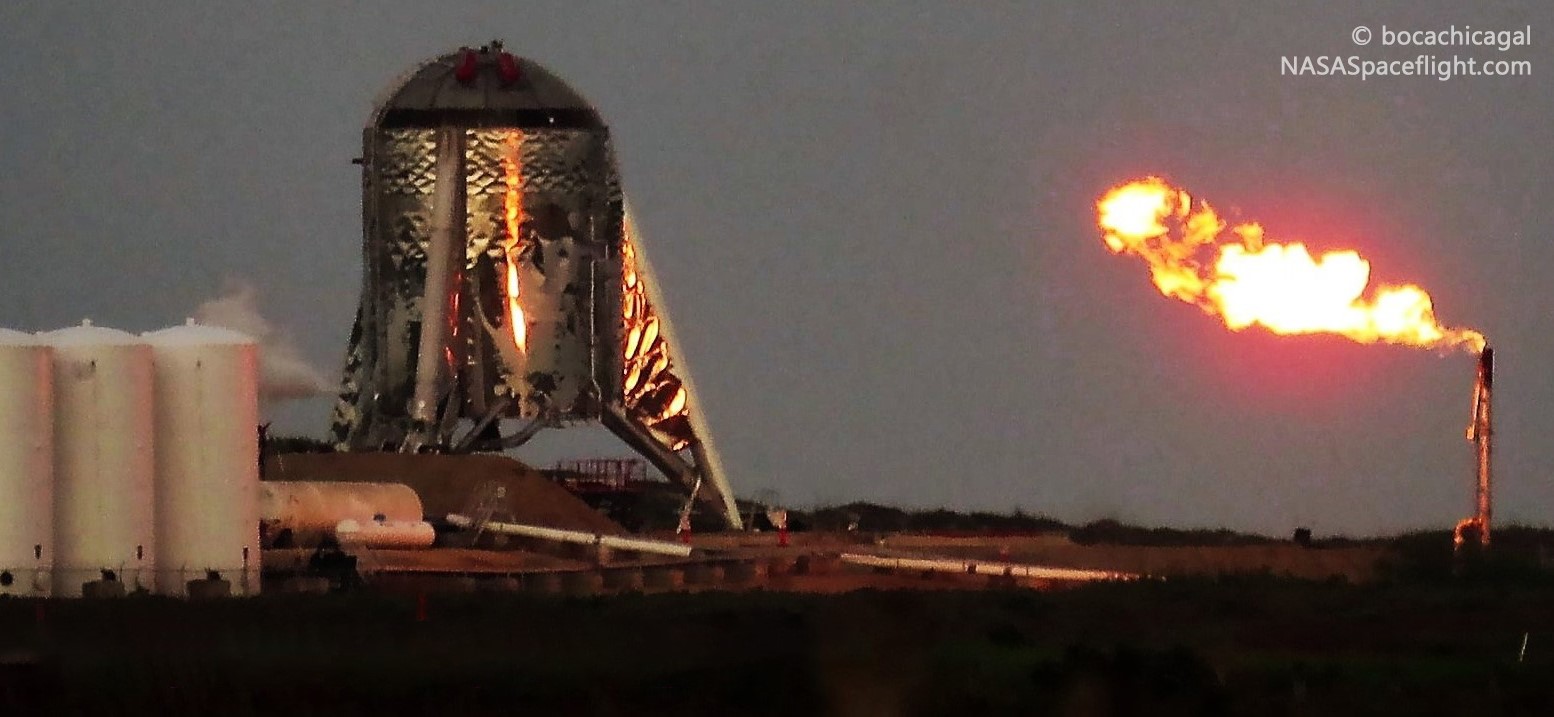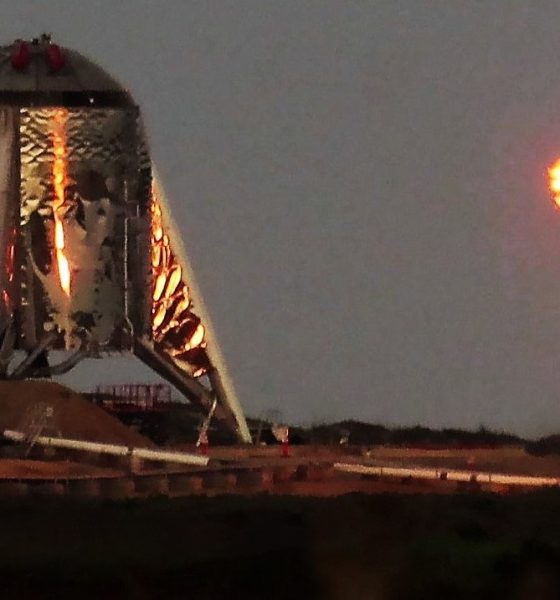

SpaceX
SpaceX’s Starship hopper steps towards first hop with several cautious tests
SpaceX’s team of South Texas engineers and technicians have dived into a program of critical pre-hop tests of the first assembled Starship prototype, a partial-fidelity vehicle – known as (Star)Hopper – meant to soon perform low-altitude, low-velocity hop tests powered by Raptor.
Despite a lack of official information is known and SpaceX’s general silence – even to local residents – about Starhopper’s testing, some barebones insight can be derived from what has and hasn’t been done or seen over the past seven days of testing, as well as five apparent wet dress rehearsals (WDRs). To verify the operational integrity of Starhopper and iron out best practices for what is effectively a one-off mobile test stand for Raptor, these WDRs (and one more active test) have seen the unusual prototype filled with some amount of liquid oxygen and methane propellant, taken to flight (hop?) pressures, and generally monitored closely to gather valuable telemetry and judge Starhopper’s condition and hop-readiness. Aside from Hopper, these tests also serve as a shakedown for complex pad and support facilities sprung up from a dirt pile in barely three months.
Fueling the beast
Starhopper’s five (ish) wet dress rehearsal tests have demonstrated an intriguing level of caution relative to the last few months of BFR program development. Depending on how much propellant SpaceX has been filled the vehicle with and how much of that propellant they are able to recycle after each attempt, each dress rehearsal could cost upwards of six figures (USD), while also putting the unusual steel structure through multiple stress cycles.
No official info has been provided beyond a brief indication that SpaceX means to static-fire Starhopper before transitioning to tethered hops, meaning that it’s quite difficult to determine what exactly the testing plan and schedule are. In other words, these ~5 WDR tests could have been the plan all along, or each test could be producing data that has lead launch engineers to scrub Raptor ignition attempts nominally planned at the end of each rehearsal. For an entirely new and unfamiliar design like Starhopper, it seems likely that at least one or two WDRs were planned before any attempt to static fire the hopper’s lone Raptor, although it could also be the case that – much like most SpaceX static fire attempts – the WDR was simply built in as a precursor to ignition, barring off-nominal telemetry.
The third and most visibly active test yet (above) occurred on March 25th and saw Starhopper briefly vent a cloud of gas from Raptor, with some viewers guessing that a Raptor preburner (partial ignition) test had been observed. It’s unclear whether this Raptor (SN02, the second produced) completed acceptance testing in McGregor, Texas on the way from California to Boca Chica. If not, then the caution on display in these WDR tests (i.e. no visible Raptor ignitions) could also be a side-effect of
The fidelity of Starhopper relative to its orbit-facing successors is also unclear. If the prototype’s structures, avionics, and plumbing are actually more indicative of the finished product than they appear, it’s possible that SpaceX tendency towards accepting the destruction of test hardware is in a bit more of a cautious state than usual, with a total loss of vehicle amounting to a significant technical setback and schedule delay. Based on the vehicle’s appearance and the apparent decision to entirely set aside the idea of installing a new fairing on Starhopper, it seems far more plausible that the prototype is more of a glorified mobile test stand for Raptor engines and Starship avionics (software) than anything else.
If Starhopper really can’t function as something more than a marginally mobile test stand for Raptor(s), then the value of actually hopping the craft could be quite minimal, perhaps offering useful data on Raptor’s control loop and behavior during flight operations. Still, CEO Elon Musk has stated several times that SpaceX has gotten good enough at the actual task of landing rockets vertically that it’s effectively a known quantity for Raptor and BFR, whereas the exotic atmospheric operations planned for Starship are the main uncertainty for successful recoveries.
Simultaneously, SpaceX is building the first orbital-class Starship prototype just a few thousand feet away from Starhopper’s new roost, utilizing stainless steel sheets almost three times thinner than the quarter-inch-thick steel the first prototype was built out of. It’s likely that Starhopper’s career will thus end up being rather short, given that the completion of the first near-final Starship would further minimize the low-fidelity hopper’s utility. If it’s actually meant to reach orbit, the newest Starship prototype will require the tripod fins and canard wings shown in SpaceX’s latest renders in order to safely land for future test flights, while Starhopper appears to be far too heavy and simplistic to warrant the expensive and time-consuming task of outfitting it with aerodynamic control surfaces and a new nose cone capable of surviving the associated forces.

While additional testing may be done on Friday, March 29th, it appears that the next attempts for the first static fire (and hop tests) will begin next week (likely Monday) – SpaceX is unlikely to test on weekends due to the potential disruption it could cause for beach-going locals.
Check out Teslarati’s Marketplace! We offer Tesla accessories, including for the Tesla Cybertruck and Tesla Model 3.

Elon Musk
Elon Musk’s Biggest Revelations on AI, Robots, and the Future of Work from the Moonshots Podcast

Elon Musk’s appearance on the Moonshots with Peter Diamandis podcast was packed with bold predictions, candid admissions, and surprising tech insights. The nearly three-hour conversation covered everything from artificial intelligence to humanoid robots, geopolitics, and the future of work. Here are the top 10 most intriguing takeaways:
-
Aggressive AGI Timeline Predictions
Musk offered a detailed view on when artificial general intelligence (AGI) could emerge, suggesting it may arrive sooner than many expect, emphasizing both transformative potential and risks.
-
U.S. vs. China in the AI Race
He discussed the strategic competition between the United States and China over AI development, noting that geopolitical dynamics will shape how and who leads in the next decades.
-
Future of Job Markets
Musk touched on how AI and automation could reshape employment, predicting massive boosts in productivity alongside potential disruptions in traditional work structures.
-
Clean Energy Transition
A recurring theme was the role of clean energy in future economies, with Musk reiterating the importance of scaling sustainable power generation and storage.
-
Humanoid Robots Are Coming
On the podcast, Musk elaborated on Tesla’s work on humanoid robots, hinting at timelines and applications that go beyond factories to general-purpose assistance.
-
Tesla Roadster “Last Human-Driven Car”
Outside the core discussion topics, Musk teased features of the upcoming Tesla Roadster — calling it “the best of the last of the human-driven cars” and suggesting safety won’t be its main selling point.
-
The Role of AI in Clean Energy and Robotics
Linking AI to both energy optimization and robotics, Musk explained how smarter systems could accelerate decarbonization and task automation across industries.
-
U.S. Innovation Leadership
Musk argued that maintaining American leadership in key tech sectors like AI, space, and robotics should be a national priority, with thoughtful policy and investment.
-
Job Creation vs. Job Elimination
While acknowledging automation’s disruptive effects, he also outlined scenarios where new industries and opportunities could emerge, particularly in AI, space, and advanced manufacturing.
-
Long-Term Vision for Humanity
Throughout the conversation, Musk revisited his long-term philosophical views — including a belief in humanity’s responsibility to become a multi-planetary and technologically empowered species.
Whether you agree with Musk’s optimism or not, the podcast offers a window into the thinking of one of the most influential figures in tech today, in and why his visions continue to spark debate and inspiration.
Elon Musk
Starlink achieves major milestones in 2025 progress report
Starlink wrapped up 2025 with impressive growth, adding more than 4.6 million new active customers and expanding service to 35 additional countries, territories, and markets.

Starlink wrapped up 2025 with impressive growth, adding more than 4.6 million new active customers and expanding service to 35 additional countries, territories, and markets. The company also completed deployment of its first-generation Direct to Cell constellation, launching over 650 satellites in just 18 months to enable cellular connectivity.
SpaceX highlighted Starlink’s impressive 2025 progress in an extensive report.
Key achievements from Starlink’s 2025 Progress
Starlink connected over 4.6 million new customers with high-speed internet while bringing service to 35 more regions worldwide in 2025. Starlink is now connecting 9.2 million people worldwide. The service achieved this just weeks after hitting its 8 million customer milestone.
Starlink is now available in 155 markets, including areas that are unreachable by traditional ISPs. As per SpaceX, Starlink has also provided over 21 million airline passengers and 20 million cruise passengers with reliable high-speed internet connectivity during their travels.
Starlink Direct to Cell
Starlink’s Direct to Cell constellation, more than 650 satellites strong, has already connected over 12 million people at least once, marking a breakthrough in global mobile coverage.
Starlink Direct to Cell is currently rolled out to 22 countries and 6 continents, with over 6 million monthly customers. Starlink Direct to Cell also has 27 MNO partners to date.
“This year, SpaceX completed deployment of the first generation of the Starlink Direct to Cell constellation, with more than 650 satellites launched to low-Earth orbit in just 18 months. Starlink Direct to Cell has connected more than 12 million people, and counting, at least once, providing life-saving connectivity when people need it most,” SpaceX wrote.
Elon Musk
Starlink passes 9 million active customers just weeks after hitting 8 million
The milestone highlights the accelerating growth of Starlink, which has now been adding over 20,000 new users per day.

SpaceX’s Starlink satellite internet service has continued its rapid global expansion, surpassing 9 million active customers just weeks after crossing the 8 million mark.
The milestone highlights the accelerating growth of Starlink, which has now been adding over 20,000 new users per day.
9 million customers
In a post on X, SpaceX stated that Starlink now serves over 9 million active users across 155 countries, territories, and markets. The company reached 8 million customers in early November, meaning it added roughly 1 million subscribers in under seven weeks, or about 21,275 new users on average per day.
“Starlink is connecting more than 9M active customers with high-speed internet across 155 countries, territories, and many other markets,” Starlink wrote in a post on its official X account. SpaceX President Gwynne Shotwell also celebrated the milestone on X. “A huge thank you to all of our customers and congrats to the Starlink team for such an incredible product,” she wrote.
That growth rate reflects both rising demand for broadband in underserved regions and Starlink’s expanding satellite constellation, which now includes more than 9,000 low-Earth-orbit satellites designed to deliver high-speed, low-latency internet worldwide.
Starlink’s momentum
Starlink’s momentum has been building up. SpaceX reported 4.6 million Starlink customers in December 2024, followed by 7 million by August 2025, and 8 million customers in November. Independent data also suggests Starlink usage is rising sharply, with Cloudflare reporting that global web traffic from Starlink users more than doubled in 2025, as noted in an Insider report.
Starlink’s momentum is increasingly tied to SpaceX’s broader financial outlook. Elon Musk has said the satellite network is “by far” the company’s largest revenue driver, and reports suggest SpaceX may be positioning itself for an initial public offering as soon as next year, with valuations estimated as high as $1.5 trillion. Musk has also suggested in the past that Starlink could have its own IPO in the future.








